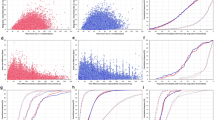Abstract
Background
Thorough QT studies are typically conducted for drugs with systemic bioavailability and include a positive control, typically moxifloxacin, with a well-described QTc effect.
Objective
This study tested two hypotheses: that (i) re-measuring the QT intervals based on electrocardiogram (ECG) pattern similarity improves the moxifloxacin time profile, and (ii) that study conduct influences the ability to detect a typical moxifloxacin time profile.
Methods
ECGs from 65 studies with available moxifloxacin plasma concentrations were obtained, including four studies with an unexpected moxifloxacin response. Residual error of a concentration–QT model was evaluated before and after re-measuring the QT interval based on ECG pattern similarity. Intra-replicate heart rate differences were calculated using the original heart rate measurements and the 10-s average heart rates.
Results
Similarity re-measurements reduced the residual error of the model (before vs. after of 8.43 ± 2.00 vs. 7.55 ± 1.86 ms; p < 0.001). For both original and averaged 10-s heart rate, intra-replicate heart rate differences were significantly lower (p < 0.001) in studies with the expected response than in those with an unexpected time profile.
Discussion
The pattern similarity measurement methodology reduces the residual error of the model, which influences the time profile of the moxifloxacin response. Accuracy of study conduct, represented by intra-replicate heart rate differences, separated studies with and without the expected moxifloxacin time profile.




Similar content being viewed by others
References
ICH. Guidance for Industry E14 Clinical Evaluation of QT/QTc interval prolongation and proarrhythmic potential for non-antiarrhythmic drugs; 2005.
ICH. Guidance for Industry E14 Clinical Evaluation of QT/QTc interval prolongation and proarrhythmic potential for non-antiarrhythmic drugs. Questions and answers; 2008.
Malik M, Garnett CE, Zhang J. Thorough QT studies: questions and quandaries. Drug Saf. 2010;33(1):1–14.
Bloomfield DM, Kost JT, Ghosh K, Hreniuk D, Hickey LA, Guitierrez MJ, et al. The effect of moxifloxacin on QTc and implications for the design of thorough QT studies. Clin Pharmacol Ther. 2008;84(4):475–80.
Malik M, Hnatkova K, Schmidt A, Smetana P. Electrocardiographic QTc changes due to moxifloxacin infusion. J Clin Pharmacol. 2009;49(6):674–83.
Iwamoto M, Kost JT, Mistry GC, Wenning LA, Breidinger SA, Marbury TC, et al. Raltegravir thorough QT/QTc study: a single supratherapeutic dose of raltegravir does not prolong the QTcF interval. J Clin Pharmacol. 2008;48(6):726–33.
Kubitza D, Mueck W, Becka M. Randomized, double-blind, crossover study to investigate the effect of rivaroxaban on QT-interval prolongation. Drug Saf. 2008;31(1):67–77.
Florian JA, Tornoe CW, Brundage R, Parekh A, Garnett CE. Population pharmacokinetic and concentration–QTc models for moxifloxacin: pooled analysis of 20 thorough QT studies. J Clin Pharmacol. 2011;51:1152–62.
Garnett CE, Zhu H, Malik M, Fossa AA, Zhang J, Badilini F, et al. Methodologies to characterize the QT/corrected QT interval in the presence of drug-induced heart rate changes or other autonomic effects. Am Heart J. 2012;163(6):912–30.
Hnatkova K, Smetana P, Toman O, Bauer A, Schmidt G, Malik M. Systematic comparisons of electrocardiographic morphology increase the precision of QT interval measurement. Pacing Clin Electrophysiol. 2009;32(1):119–30.
Fridericia LS. Die Systolendauer im Elektrokardiogramm bei normalen Menschen und bei Herzkranken. Acta Med Scand. 1920;54(1):17–50.
Garnett CE, Beasley N, Bhattaram VA, Jadhav PR, Madabushi R, Stockbridge N, et al. Concentration–QT relationships play a key role in the evaluation of proarrhythmic risk during regulatory review. J Clin Pharmacol. 2008;48(1):13–8.
Johannesen L, Galeotti L. Automatic ECG quality scoring methodology: mimicking human annotators. Physiol Meas. 2012;33:1479–89.
Meyer O, Ferber G, Greig G, Holzgrefe HH. Pattern recognition analysis of digital ECGs: decreased QT measurement error and improved precision compared to semi-automated methods. J Electrocardiol. 2013;46(2):118–25.
Malik M, Hnatkova K, Novotny T, Schmidt G. Subject-specific profiles of QT/RR hysteresis. Am J Physiol Heart Circ Physiol. 2008;295(6):H2356–63.
Acknowledgments
The opinions presented here are those of the authors and no official support or endorsement by US Food and Drug Administration is intended or should be inferred. Lars Johannesen, Christine Garnett, and Marek Malik have no conflicts of interest directly related to this article. Marek Malik is an Honorary ORISE Research Fellow of the US Food and Drug Administration.
The authors are grateful to Dr. Norman Stockbridge of the US Food and Drug Administration for his substantial guidance on the topic and his help with preparing the manuscript. This project was supported in part by an appointment to the Research Participation Program at the Center for Drug Evaluation and Research administered by the Oak Ridge Institute for Science and Education through an interagency agreement between the US Department of Energy and the US Food and Drug Administration.
Author information
Authors and Affiliations
Corresponding author
Rights and permissions
About this article
Cite this article
Johannesen, L., Garnett, C. & Malik, M. Impact of Electrocardiographic Data Quality on Moxifloxacin Response in Thorough QT/QTc Studies. Drug Saf 37, 183–189 (2014). https://doi.org/10.1007/s40264-014-0142-2
Published:
Issue Date:
DOI: https://doi.org/10.1007/s40264-014-0142-2




